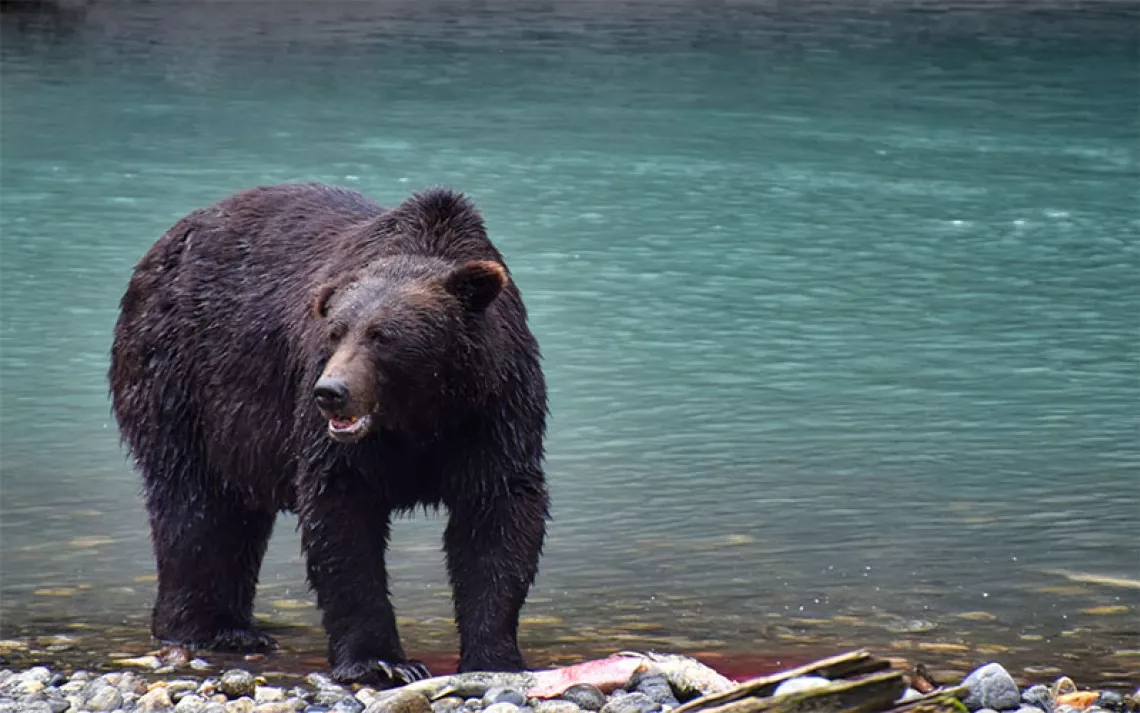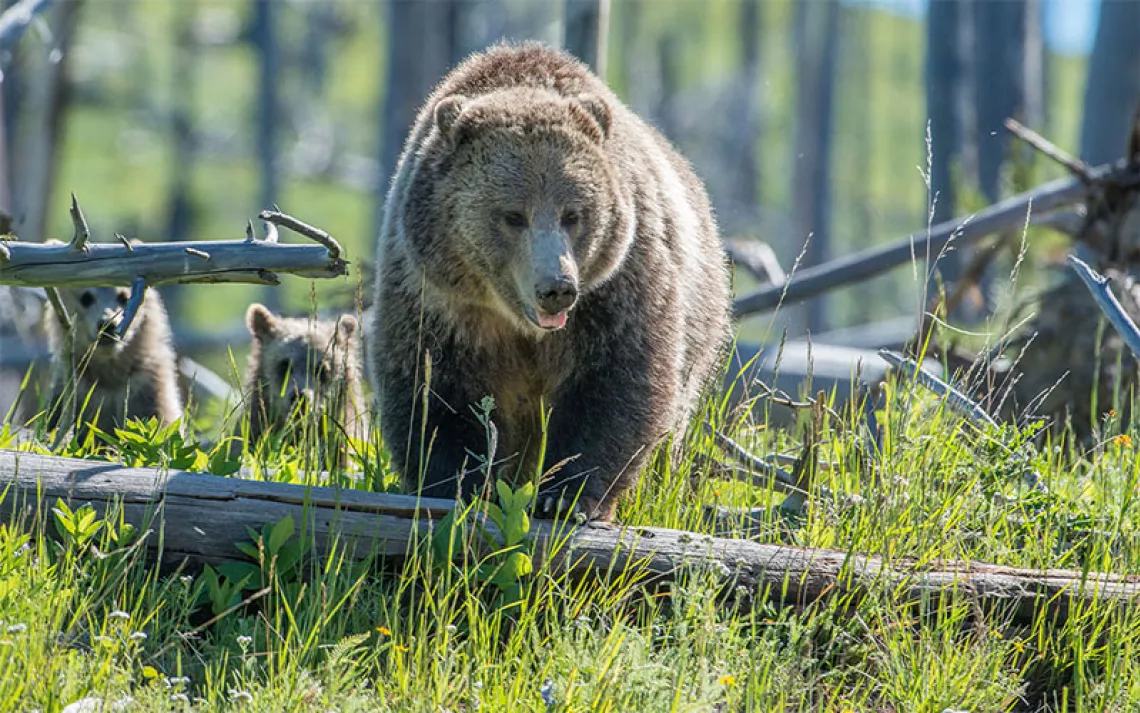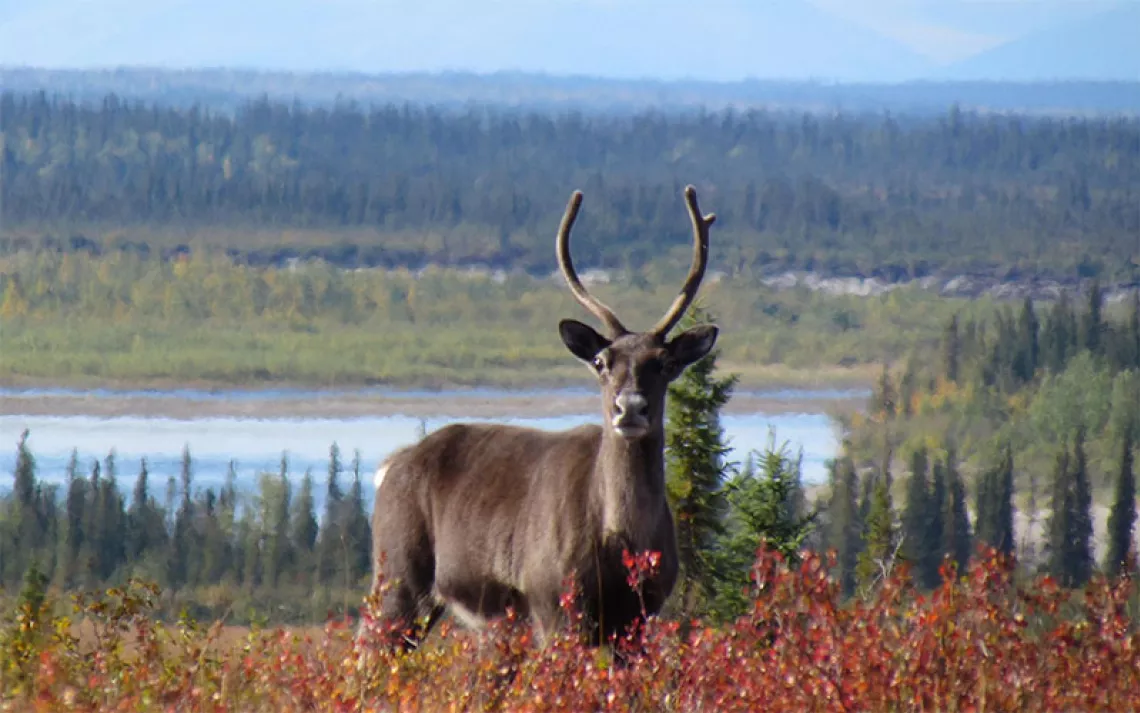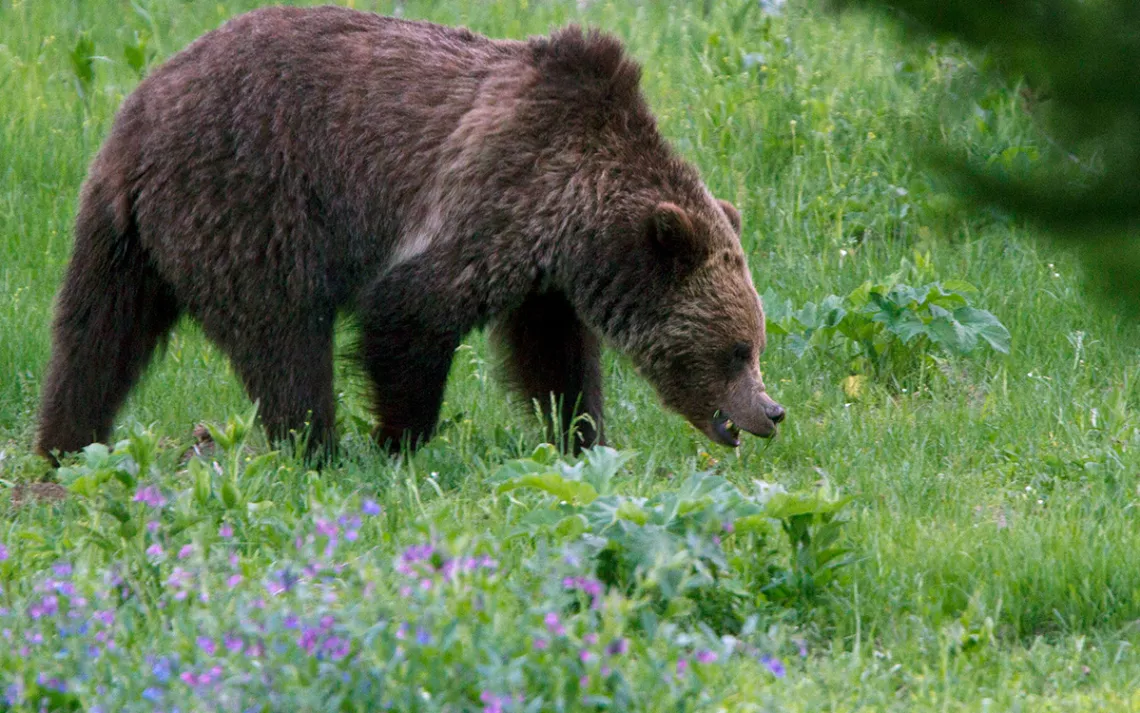Does a Bear Think in the Woods?
Turns out animal intelligence is not so different from our own
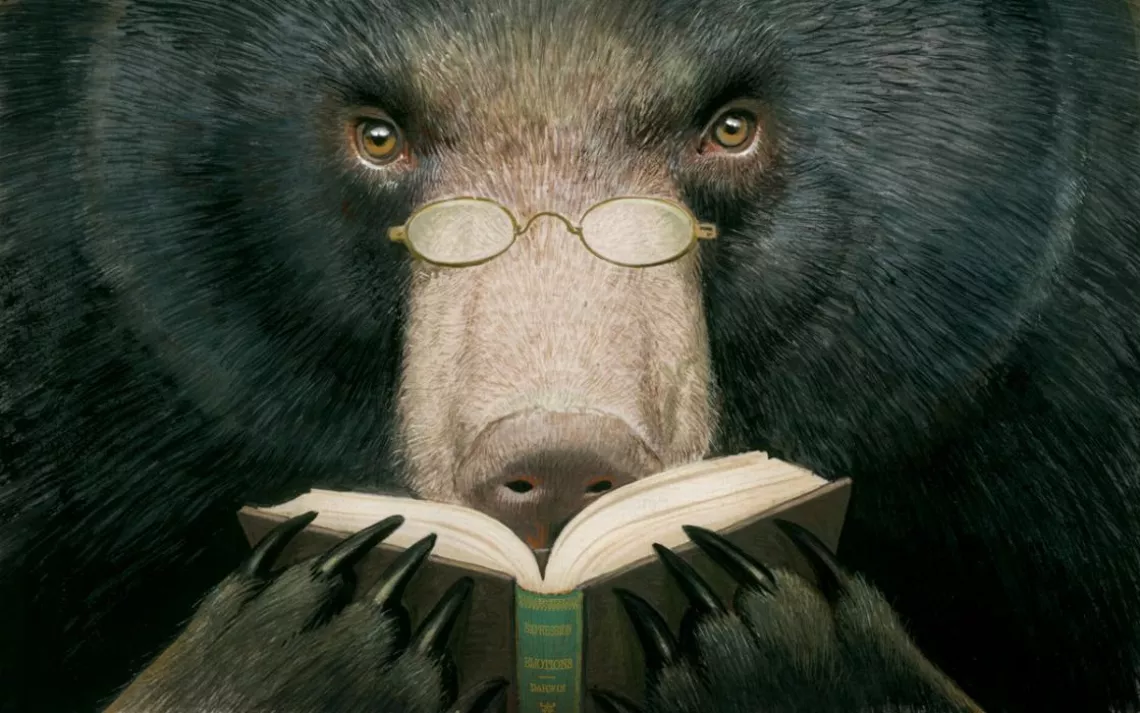
Illustrations by Bill Mayer
IN MARCH 1996, STATE WILDLIFE OFFICIALS DELIVERED THREE ORPHANED BLACK BEARS to Ben Kilham's door in Lyme, New Hampshire. Just seven weeks old, they weighed no more than four pounds apiece. They should have been inside their mother's den, in the warmth between womb and world where each bear's life begins. Instead, a logging operation had sent mom fleeing. So Kilham, a former wildlife biology student turned gunsmith and state-licensed bear rehabilitator, became their foster mother.
He bottle-nursed the cubs and fashioned a basket den in his guest bedroom. When spring arrived, Kilham walked the cubs in the woods, teaching them as best he could what to eat and introducing them to wild bears. He was protective, and also curious: Dyslexia had stifled his academic dreams of studying animal behavior, but a passion for wildlife remained. Fifteen months later, Kilham released the orphans into the wild. Two left the area, but one, whom he named Squirty, took up residence on the forested slopes of the White Mountains near Kilham's home and rehabilitation facility.
Twenty-two years later, Squirty's still in the neighborhood, and one early-October evening, Kilham drives me several miles up a dirt track to a clearing where she can be found. Squirty, who now weighs about 180 pounds, is there. So is her extended family, whom Kilham recognizes by sight. There's one of her daughters, Demi, and granddaughter SQ2LO—her prosaic name signaling Kilham's transition from curious to rigorous observer—and a great-granddaughter, Lightface. There are 22 bears altogether, the cubs gamboling, the rest waiting quietly around the clearing's edges.
Kilham leaves me in his pickup truck and fetches two buckets of dried corn from its bed. Tall and slab-framed, he has an easygoing bulk that, cliché but inescapable, seems almost ursine as he pours a circuit of small piles. It's not nearly enough to sustain the bears, but it's a reliable snack that, like the bananas Jane Goodall provided when she began her chimpanzee studies, gives Kilham a chance to watch them. As the bears tuck in, he starts taking notes, just as he's done most evenings for more than a decade.
Kilham's observations collected while following radio-collared bears, along with genetic analyses of their identities, constitute one of the richest repositories of information ever gathered about black bears. Among his findings: Bears are quite social (the bears in Kilham's meadow represent two distinct clans); they have a society of sorts, a matriarchy that in this case is governed by Squirty; they use a rich system of communication; they are highly self-aware; and, perhaps most surprising, they are governed by long-term relationships and rules of conduct.
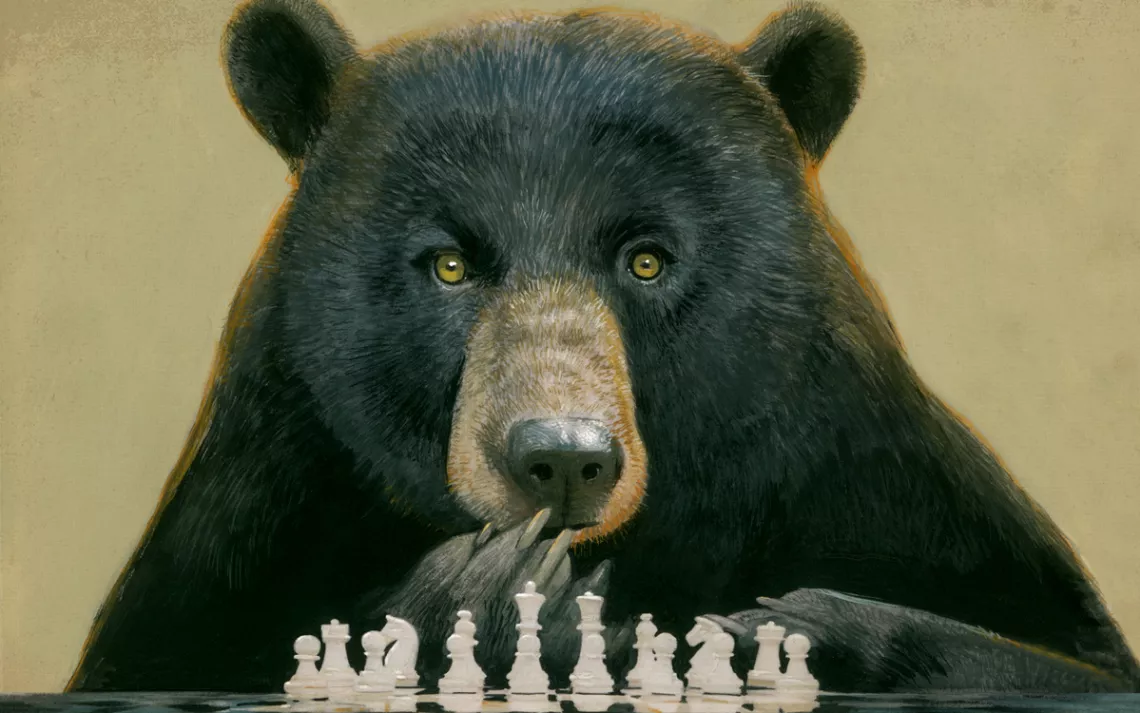
Kilham thinks these dynamics reflect, and across evolutionary time have shaped, black bear intelligence—an intelligence comparable to that of chimpanzees and other great apes and sharing many properties with our own. "They're like us," he says. "They judge. They punish. They have gratitude and friendship. But because they're bears, people see them in the light of conflict." After a while, Squirty ambles over. "You look pretty good for 22," he murmurs in response to her rumblings.
As I look at Squirty's massive head through Kilham's open door, I think of Flo, matriarch of the chimpanzee clan studied by Goodall when she arrived in Tanzania nearly 60 years ago. At the time, mainstream science mostly denied that animals could think and feel in meaningful ways. Claims of animal intelligence, ethologist Frans de Waal writes in his 2017 best-seller Are We Smart Enough to Know How Smart Animals Are?, were dismissed as "anthropomorphic, romantic, or unscientific." Goodall's findings of tool-making, alliance-forming, emotionally complicated chimps helped seed a revolution.
Nowadays, science overflows with such findings. A Google Scholar search for "animal" and "cognition" returns more than 190,000 publications in just the past five years as research has illuminated a menagerie of intelligence. Ravens can plan for the future and demonstrate a degree of self-control comparable to great apes'. Sperm whales engage in consensus-based decision-making during the course of their travels. Japanese great tits, songbirds related to chickadees, use syntax—a linguistic property long thought unique to human language—when they communicate. Experiments show that tiny zebra fish, a species used to model basic animal traits, possess detailed memories of events and can learn from one another. Many species possess emotions: Giraffes appear to grieve, bumblebees show signs of happiness, and crayfish can experience anxiety.
On and on the findings go, yet bears have remained in shadow. Though plenty is known about bears' biology and ecological interactions—as well as how to regulate hunting seasons—science is just starting to pay attention to what's going on in their heads. At any given moment, researchers are conducting long-term field studies or experimental tests on primate cognition—but Kilham is almost alone in his studies of bear intelligence. This research highlights an intriguing possibility: Could it be that much of North America is populated by hundreds of thousands of exceptionally intelligent nonhuman beings?
AMONG THE BEDROCK PROPERTIES of our own minds—minds encompassing the capacities of thought and feeling that constitute intelligence—is that of self-awareness, a sense of one's self as distinct from others. Self-awareness is so integral to our own intelligence that it's practically impossible to imagine its absence. Assessing it in animals, however, is contentious.
One common approach, developed by psychologist Gordon Gallup in the 1970s, involves observing whether animals recognize themselves in a mirror. Humans generally do this as toddlers, but only a few other species—among them bottlenose dolphins, some great apes, Asian elephants, and magpies—have passed the test. Since the mirror test detects only the forms of self-awareness closest to our own, researchers disagree about whether it is actually found far more broadly throughout the animal kingdom. But recognizing oneself is certainly a powerful ability.
Propped against a tree in Squirty's clearing is a tall, wood-framed mirror. On this night, the bears ignore it—but that's not always the case. In Kilham's 2014 book, In the Company of Bears, and in the thesis that earned him a PhD in 2015 at the age of 63, he describes bears passing through the stages of recognition. They licked and sniffed the mirror to determine whether the reflection belonged to a stranger; looked behind it; mimed to their reflections, repeating the same actions over and over; and finally, as recognition dawned, inspected themselves. "Black bears passed all four levels of the mirror self-recognition test developed by Gallup," Kilham wrote in his thesis—a landmark claim, though one that hasn't yet passed the peer-review gauntlet required for publication in a scientific journal. A skeptic might argue that the bears merely became accustomed to their reflections without truly recognizing themselves.
Such scientific objections miss a larger point: For most of human history, animal self-awareness was taken for granted. Many so-called primitive societies believed animals "to have essentially the same sort of animating agency which man possesses," writes anthropologist A. Irving Hallowell in Bear Ceremonialism in the Northern Hemisphere. "They have a language of their own, . . . have forms of social or tribal organization, and live a life which is parallel in other respects to that of human societies." If that sounds too anthropomorphic—indeed unscientific—it's worth considering that early humans knew animals with a detailed intimacy now reserved for pets.
Bears merited a special veneration. Samis in northern Scandinavia spoke of "the old man with the fur garment." The Yakuts of northeastern Asia called brown bears "beloved uncle" and "grandfather." The Abenaki tribes of southern Quebec and western New England would have called Squirty "cousin."
Ancient peoples even learned from bears. In the Journal of Ethnobiology and Ethnomedicine, linguist Valeria Kolosova and colleagues related that Eurasian languages contain more than 1,200 plant names derived from bears: bearberries and bear's garlic and bear's cabbage and so on. "The Native American 'pharmacopoeia' was replete with plants they derived from watching bears collect herbs, berries, and roots," Kolosova's team wrote.
In Europe, however, aversion eventually replaced reverence. Agrarian societies treated bears as competitors rather than fellow denizens. They symbolized wildness—and much as so-called wildlands and wild people were subjugated and exploited, so were bears. During the Middle Ages, bear torturing was a common public entertainment, and the animals' very intelligence became a tool of degradation as they were turned into circus performers. Meanwhile, Christian scholars portrayed animals as inferior to humans, who were, according to the Bible, fashioned in God's image. Theologian Thomas Aquinas characterized animals as "without intellect" and controlled by instincts as thoughtless "as the upwards motion of fire." Such prejudices went on to shape Enlightenment thought. French philosopher and mathematician René Descartes, a foundational figure in the emergence of modern science, likened animals to wind-up toys: Though animated, they were unthinkingly mechanical.
Not all scientists were so close-minded. Notable among them was Charles Darwin, whose The Expression of the Emotions in Man and Animals argued that evolution applied to mental properties as well as anatomical traits. (Bears appear in a footnote to Darwin's discussion of frowns as expressions of mental concentration.) Yet even as evolutionary theory ascended, claims of animal intelligence foundered. Scientists who theorized about animal intelligence were rebuked for relying on anecdotes. Sometimes the rebukes were fair, though one could speculate that animal intelligence was instinctively uncomfortable for societies founded on narratives of uninhabited wilderness awaiting a civilizing touch.
Biases against animal intelligence were transplanted to North America, where in the United States and Canada nature would become the domain of hunting-and-fishing-focused wildlife management and, later, conservation biology. Animal intelligence was not high on either discipline's research agenda. Behaviorism, a theory that viewed animals as little more than Cartesian machines, dominated the academy. "Other species," wrote behaviorist B.F. Skinner in 1974, are "conscious in the sense of being under stimulus control."
By the time scientists started taking animal thoughts and feelings seriously again, it was more common to travel to Africa to study chimps than to ask questions about the bears outside town.
IT ALSO DOESN'T HELP THAT BEARS, big and powerful and expensive to care for, are ill-suited to captive study. "No universities are going to have a bear lab like they would have a rat or dog or primate lab," says Gordon Burghardt, an ethologist at the University of Tennessee, Knoxville. "And the people who you think would be really interested in bears, their concern is how to manage them for hunters."
Now renowned for his pioneering research on animal play and reptile cognition, Burghardt in the mid-1970s studied the intelligence of two captive orphaned black bear cubs. "These animals are very intelligent," he says. "They're up there with chimpanzees in many cognitive capacities." The cubs grew up quickly, though, and few researchers followed in his path.
Subsequent observations often came from people outside academia. Among them were the late Charlie Russell, a Canadian naturalist who raised brown bear cubs on Russia's Kamchatka Peninsula; Steve Stringham, one of Burghardt's students, who now runs wildlife tours in Alaska; the late Else Poulsen, a zookeeper who wrote about bear emotion; Lynn Rogers, formerly a Minnesota state wildlife biologist, who now hosts bear behavior seminars; and Bill Kilham.
Common to these figures are their lives in unusual proximity to bears. To Barbara Smuts, a researcher at the University of Michigan who has studied social relationships in baboons, chimpanzees, and dolphins, that familiarity outweighs Kilham's long-standing lack of institutional credentials. "He has a tremendous feeling for the bears," she says. "That shouldn't be dismissed just because it can't be quantified. He's a true naturalist."
Kilham's early experiences with Squirty and other cubs led to meeting yet more bears. With permission from the New Hampshire Fish and Game Department, he radio-collared and followed dozens and eventually established the feeding site where we sit as darkness falls. Tonight it's mostly quiet. The adults are already conserving energy for winter. The cubs are restive, though, and two who've scaled a tree begin to moan. "They want their mother," Kilham says and begins to translate the scene for me. "Here she comes. She manages them with gulps and chirps"—he mimics the bear sounds—"and she wants them to come down. She'll sit at the base of the tree and gulp, and they'll come down. She wants them to walk her way, so she'll gulp and walk away. It's a syntax between body language and gulp. But she has to teach them the meaning of those sounds. It's not instinctive."
Just that fleeting interaction packs a lot of cognition. Mom, by Kilham's account, understands her cubs' mental state and communicates intentionally rather than reflexively voicing arousal. She uses a syntax that recombines and reorders "words" and teaches her cubs their meaning. But do mom's vocalizations reveal what's known as "theory of mind"—an ability to reason about the intentions of other individuals, which many scientists still consider unique to humans? How can Kilham be sure about the mother's intent?
It's just one anecdote, but illustrative and intriguing nevertheless (and it's one of many). Even Jane Goodall's original work, says Ellen Furlong, director of the Comparative Cognition Lab at Illinois Wesleyan University, "wasn't some gold-star standard of cognitive research. But it was groundbreaking—a really important place to start."
In assessing claims of intelligence in creatures whose behaviors are suggestive but not yet well studied, Furlong advises considering the animals' ecological niche and life history. These shape the capacities of every lineage. Black bears are generalist omnivores, eating a rich variety of foods and adapting readily to local conditions, a lifestyle thought to nourish cognitive flexibility. Another great influence on black bears, Kilham says, is their sociality.
It's a word seldom applied to bears. Besides descriptions of mother-and-cub relations and grizzlies feeding together on salmon runs, bears are usually depicted as solitary. It's quite the opposite, argues Kilham. He's observed, as did Lynn Rogers, that black bears encounter each other frequently and sometimes congregate around food. And because Kilham has run genetic identifications on the bears living near his rehabilitation center, he can also trace their family trees. He's identified a matrilineal hierarchy with Squirty on top, presiding over an extended family with overlapping home ranges that stretch for miles.
In addition to Squirty's kin, another clan is represented in the clearing. Kilham points out two descendants of Moose, an elder bear who allowed Squirty to live in her territory when Kilham released Squirty as a young orphan. Squirty now shares with Moose's clan, and that isn't coincidental, Kilham says. She's returning Moose's generosity—not because there's some genetically hardwired program governing the exchange but out of obligation. It's the sort of relationship that social hierarchy and intentional communication and self-awareness make possible. Favors are given and later returned.
Often this involves food. Squirty's home range is rich in red oak; Moose's clan lives in a beech-rich territory. When there's a bumper crop of acorns, Squirty allows nonrelated bears access to her terrain; when acorns fail to set but the beeches are bursting, Moose's clan follows suit. It makes more sense than fighting to control their individual territories. "They think highly of those who share with them," Kilham believes, "and remember them for their lifetimes."
When, in the early 1970s, evolutionary biologist Robert Trivers first theorized how such a system of exchange could evolve, it was dubbed "reciprocal altruism" and hailed as a window into the origins of human society. Perhaps black bears are another such window.
PERHAPS. It's important to recall that all of this is still just a theory. Nevertheless, Kilham's claims have heft. Richard Wrangham, one of the world's foremost primatologists, has visited with Kilham and calls In the Company of Bears "a brilliant revelation." The esteemed biologist and conservationist George Schaller, who sat on Kilham's dissertation committee, credits Kilham with "not trying to humanize bears but trying to describe exactly what they do and think as bears."
Ellen Furlong says that Kilham's findings should prompt cognitive scientists "to get in there and tease apart the mechanisms and the behaviors." Although the rigorous experiments performed with well-studied animals like ravens and jays—string-pulling tests of causal reasoning, food-hiding tasks that gauge a bird's awareness of what others know—are rarely done with bears, there are a few such studies. Most of them come from Jennifer Vonk, a comparative psychologist at Oakland University in Michigan and head of the school's Laboratory of Cognitive Origins. Vonk previously worked at the University of Southern Mississippi, near a small zoo that kept four black bears. She trained them to use a touch-screen interface, which let her perform various experiments. She could test number sense, for example, by presenting a bear with two sets of dots, then rewarding it with a snack for selecting the greater quantity. Then, to be sure the bear actually counted dots rather than gauging surface area, Vonk tweaked the dots' size, presenting arrays that contrasted a few large dots with many tiny points. Indeed, the bears could discern quantities.
In another set of experiments, Vonk tested whether bears could discriminate between images belonging to different conceptual categories: primates and hooved animals, carnivores and herbivores, animals and landscapes. In a study published in Animal Cognition, Vonk described a bear at the Detroit Zoo recognizing photos of objects—a football, a shovel, a watering can—that the bear had previously seen, and also recognizing objects first encountered in photos. Such tasks sound rudimentary, but they're not meant to encapsulate intelligence. They identify potentials: numeracy, concept formation, abstraction. Black bears "appear to display cognitive abilities commensurate with those of the great apes," Vonk wrote in another journal, Animal Behavior and Cognition.
Anecdotes open up further lines of inquiry. Kilham describes how bears climb oaks in midsummer to examine budding acorns, as if checking what autumn's crop will bring. Might they be making long-term plans? Researchers in Russia have documented brown bears eating clay, ostensibly to prevent diarrhea caused by a salmon-rich diet. How did they learn that? When a black bear in Upstate New York started opening the latest in bear-proof canisters, other local bears soon followed suit. Did she teach them?
Such questions don't even touch on emotions, which are notoriously difficult to study empirically; until recently, talk of animal feelings was considered unscientific. That's no longer the case, Furlong says, and emotions are now recognized as a basic, widespread evolutionary adaptation. "We'll be learning more about emotion," she says, "but we're just at the cusp of beginning to move in that direction."
In her book Carnivore Minds, psychologist and ecologist Gay A. Bradshaw, best known for documenting social breakdown among African elephants that saw family members killed, suggests that bears may also be deeply affected by death. It's just a hypothesis, but it's worth investigating. Lynn Rogers, whose thousands of bear video clips are being collated by Gordon Burghardt, describes a bear rushing to her dead brother's side even as other bears ignored him. The sister bear sniffed her brother "for the longest time," recalls Rogers, then dragged the body 50 feet before finally walking away with a last backward glance.
THE DAY AFTER I VISIT Squirty's meadow, Kilham's sister Phoebe, who oversees day-to-day care at the Kilham Bear Center, takes me on a tour of the surrounding woods. She points out a duckweed-covered wallow where bears cool on hot summer days—they approach it using a stiff-legged gait that leaves especially deep, individually identifiable tracks—and a nearby red pine marked at bear height by a palimpsest of scratches. These tracks and scratches, as well as scent deposits, are part of the ursine communication repertoire. They don't just vocalize and gesture; they leave messages. Phoebe likens the scratches to hobo signs.
Seen through this lens, a bear's landscape is a place inscribed with the etchings of society. That would make the woods something we might call a neighborhood rather than mere habitat; it might prompt us to consider the residents as thinking, feeling individuals as opposed to mere creatures. Chris Darimont, a conservation scientist at the University of Victoria in British Columbia, has suggested that people should view wildlife habitat issues in a new light: Environmental degradation isn't just about animal population trends; it's also about animals' lived experience of hardship. When a bulldozer clears a wood to make way for human residences, it destroys many homes first. Darimont also emphasizes that, when considering animals and our ethical relations to them, it's enough to know that they suffer. Compassion isn't contingent on intelligence.
Fair enough—yet it does seem that intelligence, however measured, adds to the moral calculus. Few of us would equate the plight of a stranded jellyfish with that of a beached whale. What sort of ethical regard, then, is owed to a bear?
For starters, we should strive to replace our culture's fear of bears with a spirit of understanding and respect. Such respect is incompatible with killing bears for sport or profit—and while outlawing bear hunting is an unlikely event in many places, nonhunters should be represented on the state committees that regulate hunting. They can give voice to those who don't speak in human tongues.
And hunting isn't the only threat to bears: Equally important is how to live with them. No bear should die because someone didn't secure their trash. Maybe we should spend a small fraction of the nation's many billions of public infrastructure dollars on bear-proof canisters, as a gesture of neighborly generosity. And what happens when our efforts at coexistence prove insufficient and we accidentally harm or kill bears? We then have an obligation to care for the casualties, to show them compassion, just as the Kilhams have done for decades.
Phoebe takes me to feed the cubs. It's been a bad year: Trees in the region produced few nuts and bears are wandering far in search of food. Many mothers have been hit by cars or have ventured onto the property of trigger-happy landowners.
By late autumn, the center will house 60 orphans, but on this day, there are nine. As we approach, all but one retreat to the security of the trees. The lone greeter is named Trebo. Knee high, with a striking white crescent on her chest, she was found in spring after an ice storm. "She's the boss," Phoebe says. "If she says we have to go, we have to go." Trebo presses up against Phoebe, sniffing her legs and then my own, and calls out, but the other bears stay hidden.
After a while, a male cub appears and makes a short run toward us. "That's a false charge," Phoebe explains. "He's not mad. It just means 'move along.'"
As we walk away, though, the male cub follows, seemingly reluctant to say goodbye. It's considered a challenge, so I try not to look in his eyes. But I can't help being captivated by their depth.
This article appeared in the March/April 2019 edition with the headline "Does a Bear Think in the Woods?"
Learn about what people in Boulder, Colorado, are doing to live peacefully beside bears: sc.org/boulder-bears.
Intelligence All Around Us
For much of modern history, people have considered human intelligence to be radically unlike that of any other animal. A growing body of research shows that, in fact, many of our mental capacities are common among other species.
Forward-Looking Chickadees
Each autumn, black-capped chickadees prepare a winter larder by stashing thousands of seeds in bark crevices. Whether they actively plan for the coming months or simply follow instinct's imperatives—or both—is an open question, but experiments by psychologists Miranda Feeney and David Sherry at the University of Western Ontario show that chickadees engage in "anticipatory cognition." They use their memories to go back and forth in time.
Playful Alligators
Play is more than a fun way of passing time. It's a vehicle for social lessons in fairness and for learning about the physical properties of objects, how one's own body moves, and how to think creatively. Even alligators play; ethologist Vladimir Dinets has documented them frolicking beneath falling water and riding on one another's backs.
Emotional Bees
When people feel happy, they're more likely to take chances. When they're sad, they tend to play it safe. The same holds for bees. Following a simulated attack on their hive, honeybees are reluctant to investigate an ambiguously bittersweet smell; they behave pessimistically. Conversely, researchers found that after a tasty syrup snack, bumblebees quickly follow that bittersweet scent. They're optimistic—and, as reported in Science, a dopamine-blocking drug reverses their behavior. The neurotransmitters involved in regulating our emotions also regulate theirs.
Caring Rats
Labels like "pest" and "vermin" make it easy to avoid thinking about Norway rats as individuals—no small irony, since research on their lab-bound kin has taught us more about the rat mind than we know about that of probably any other nonhuman animal. But rats are quite sensitive. Peggy Mason, a University of Chicago neurobiologist, found them so distressed by the discomfort of trapped friends that they ignored chocolate in their haste to help.
Mindful Sunfish
Until recently, conventional wisdom said that fish can't even feel pain. Today, however, fish cognition research is flourishing, and old assumptions are being overturned. Fish behaviors may reflect considerable intelligence: Studies show that bluegill sunfish recognize their children, remember fish they've met before, and modulate interactions according to memories of past encounters.
Communicating Crows
American crows trapped by students of John Marzluff, a corvid cognition expert at the University of Washington, scolded the researchers for months after being released. So, for that matter, did crows that were not trapped. The birds learned from their peers about the untrustworthy humans. These findings hint at the social dynamics shaping crow cognition. They live, as do we, in fission-fusion societies, moving between different groups—family, feeding flock, teeming autumn roosts—with whom they share information and negotiate relationships.
 The Magazine of The Sierra Club
The Magazine of The Sierra Club
